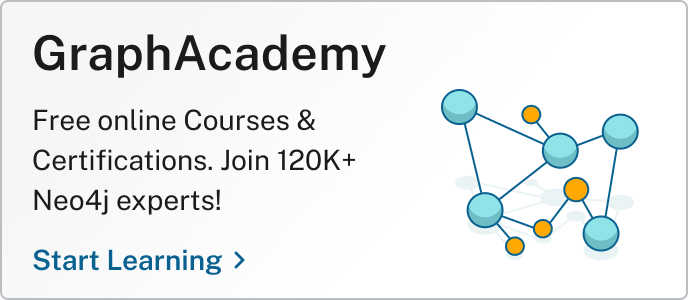Solve Hard Graph Problems With Cypher 25

Field Engineer, Neo4j
7 min read

Graphs are a powerful way to model complex relationships, from social networks to supply chains. As a developer at Neo4j, I love testing Cypher’s capabilities with challenges like the Advent of Code (AoC) 2021 Day 12 puzzle, which involves finding all valid paths through a submarine cave system with constraints on visiting small caves.
In 2021, solving this puzzle with Cypher was a grind, requiring complex graph transformations and heavy filtering, taking 2 minutes and 24 seconds to run. With Cypher 25’s new REPEATABLE ELEMENTS match mode and allReduce function, the same puzzle is solved in just 1.2 seconds—a 120x speedup!
For developers and customers, these features mean simpler queries, faster performance, and the ability to tackle difficult graph problems with ease.
Let’s explore how Cypher 25 offers this power, using AoC Day 12 as a case study, and why it’s time to revisit old assumptions about what Cypher can do.
The 2021 Challenge: Wrestling With DIFFERENT RELATIONSHIPS Mode
Each of the 25 days of an AoC challenge is a two-part programming puzzle in which the second part is similar to the first, but with some additional complexity. The AoC 2021 Day 12 puzzle models a submarine cave system as a graph, with Cave nodes connected by bidirectional CONNECTED_TO relationships. In the first part of the puzzle, big caves (uppercase names) can be visited unlimited times, while small caves can be visited only once. Then, in the second part, small caves can still be visited once, except for one that can be visited twice. In 2021, Cypher’s only (default) match mode was DIFFERENT RELATIONSHIPS, which ensured that each relationship was traversed at most once per path, while nodes could be revisited freely.
This was useful for avoiding redundant edge traversals but didn’t address the puzzle’s core challenge: constraining node visits for small caves.
The 2021 Approach
To handle these node constraints, I had to refactor the graph extensively and rely on post-traversal filtering.
Graph refactoring:
- Eliminated big caves: Replaced paths like
Small1-[:CONNECTED_TO]-Big-[:CONNECTED_TO]-Small2with directSmall1-[:CONNECTED_TO {via: Big.name}]->Small2edges. - Added loops: For the second part, created
LOOPrelationships (e.g.,Small-[:LOOP {via: Big.name}]->Small) to model small cave revisits, asDIFFERENT RELATIONSHIPSdidn’t allow repeated relationship traversals. - Created back edges: Added reverse
CONNECTED_TOedges for small caves to enable undirected traversal. - Pruned leaves: Removed small cave leaf nodes (degree 1) to simplify the first part of the graph.

Post-filtering: Used APOC procedures to enforce node constraints after traversal:
apoc.coll.occurrenceschecked node visit counts (e.g., small caves visited twice at most).apoc.coll.duplicatesensured that only one small cave was visited twice in the second part.


The second part’s query:
MATCH p = (s:Cave {name:"start"})-[:CONNECTED_TO|LOOP*0..7]-(e:Cave {name:"end"})
WITH p, [x in apoc.coll.duplicates(nodes(p)) | x.name] as dupl
WHERE all(c IN nodes(p) WHERE apoc.coll.occurrences(nodes(p), c) <= 2)
AND size(dupl) <= 1
AND NOT "start" IN dupl
AND NOT "end" IN dupl
WITH DISTINCT [n IN nodes(p) | n.name] AS smalls, [r IN relationships(p) | r.via] AS vias
RETURN count(*);This query:
- Used
[:CONNECTED_TO|LOOP*0..7]underDIFFERENT RELATIONSHIPS, ensuring that each relationship was traversed once per path. - Generated a massive set of paths due to node revisits, then filtered them with costly APOC functions.
- Required complex graph transformations, adding preprocessing overhead.
The result? A 144-second runtime, driven by exponential path exploration and heavy post-filtering. It would have been much worse had I not known a valid solution was at most seven hops deep. This meant hours of engineering to encode constraints into the graph, making the solution feel more like a workaround than a natural query.
Cypher 25: Simplified Queries and Blazing Performance
Cypher 25 introduces the REPEATABLE ELEMENTS match mode and allReduce function (see Query, Chomp, Repeat), enabling you to solve complex path-finding problems like AoC Day 12 on the original graph with a single, declarative query:
CYPHER 25 runtime=parallel
MATCH REPEATABLE ELEMENTS path = (:Start)((xs:!End)--(:!Start)){0,100000}(e:End)
WHERE allReduce(
small_visited = [],
x IN xs | CASE WHEN x:Big THEN small_visited ELSE small_visited+[x] END,
size(small_visited) <= size(apoc.coll.toSet(small_visited)) + 1
)
RETURN count(path) AS part_2;This query runs in just 1.2 seconds — a 120x speedup!
Empowering Developers and Delivering Value
REPEATABLE ELEMENTS: Flexibility Without Refactoring
Unlike DIFFERENT RELATIONSHIPS, which limits relationships to one traversal per path, REPEATABLE ELEMENTS allows nodes and relationships to be traversed multiple times. For AoC Day 12, this flexibility is critical, as the puzzle requires revisiting small caves and their connecting relationships to model the “one small cave visited twice” rule. The pattern (:Start)((xs:!End)--(:!Start)){0,100000}(e:End) with REPEATABLE ELEMENTS:
- Enables paths where small caves and relationships can be revisited, eliminating the need for 2021’s graph refactoring (e.g.,
LOOPedges and back edges). - Expands the search space compared to
DIFFERENT RELATIONSHIPS, allowing more paths to be considered.
This larger search space could lead to path explosion, but allReduce, which is applied during traversal, ensures performance remains stellar.
allReduce: Pruning Dead Branches During Traversal
The allReduce function is the secret sauce for taming the expanded search space. It tracks small cave visits during traversal by building a small_visited list, adding only small cave names (skipping :Big caves via the CASE statement). The condition size(small_visited) <= size(apoc.coll.toSet(small_visited)) + 1 ensures that exactly one small cave can be visited twice, pruning paths that violate this rule during traversal.
This is a massive improvement over 2021’s post-filtering with apoc.coll.occurrences and apoc.coll.duplicates, which processed huge path sets after traversal. The pruning is so effective that I could set a massive depth bound of 100,000 without worrying about performance, as allReduce reduces the search space from millions to thousands of paths, driving the 1.2-second runtime.
Declarative Power
Cypher 25’s query is declarative — you describe what they want (valid paths), rather than how to compute it. This contrasts with 2021’s procedural approach, where I had to engineer the graph to encode constraints due to DIFFERENT RELATIONSHIPS. The synergy of REPEATABLE ELEMENTS and allReduce lets you work on the original graph, with allReduce efficiently constraining the larger search space.
Cypher 25 also likely benefits from engine-level optimizations, such as:
- Dynamic path pruning integrated with
allReduce - Stateful tracking of node visits during traversal
- Enhanced query planning to prioritize valid paths
These improvements make Cypher 25 a game-changer, reducing coding effort and delivering faster results.
From Hard to Easy: Revisiting Old Assumptions
The leap from 144 seconds to 1.2 seconds in AoC Day 12 shows that what was once hard — or even impossible — with Cypher is now straightforward and fast.
This has big implications for Neo4j customers and developers. In the past, complex graph logic, like constrained path-finding, often required Java stored procedures, which were powerful, but hard to maintain.
Cypher 25’s REPEATABLE ELEMENTS and allReduce are two examples of recent graph pattern matching improvements that make it feasible to migrate such procedures to Cypher, resulting in simpler, more maintainable queries.
Summary
Cypher 5 and 25’s new features like REPEATABLE ELEMENTS and allReduce
Whether you’re a developer solving puzzles like AoC Day 12 or a business tackling fraud detection, recommendations, or routing, these features empower you to work with your graph’s natural structure, delivering results in seconds, rather than minutes.
A huge kudos to the Neo4j Cypher team for building these powerful tools. Now it’s your turn — go ahead and set CYPHER 25 as your database language default.
Resources
Solve Hard Graph Problems With Cypher 25 was originally published in Neo4j Developer Blog on Medium, where people are continuing the conversation by highlighting and responding to this story.



